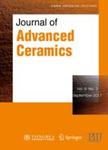Compositional modulation in ZnGa2O4 via Zn2+/Ge4+ co-doping to simultaneously lower sintering temperature and improve microwave dielectric properties
Compositional modulation in ZnGa2O4 via Zn2+/Ge4+ co-doping to simultaneously lower sintering temperature and improve microwave dielectric properties作者机构:College of Information Science and Engineering Guilin University of Technology Guangxi Key Laboratory of Optical and Electronic Materials and Devices College of Material Science and Engineering Guilin University of Technology School of Materials Science and Engineering Nanchang University
出 版 物:《Journal of Advanced Ceramics》 (先进陶瓷(英文))
年 卷 期:2021年第10卷第6期
页 面:1360-1370页
核心收录:
学科分类:08[工学] 0805[工学-材料科学与工程(可授工学、理学学位)] 080502[工学-材料学]
基 金:the financial support from the National Natural Science Foundation of China (No. 62061011) the Guangxi Zhuang Autonomous Region (Nos. 2018GXNSFAA281253 and 2019GXNSFGA245006) the High-Level Innovation Team and Outstanding Scholar Program of Guangxi Institutes
主 题:ceramics spinel composition modulation dielectric properties
摘 要:AB2O4-type spinels with low relative permittivity(εr) and high quality factor(Q × f) are crucial to high-speed signal propagation systems. In this work, Zn2+/Ge4+co-doping to substitute Ga3+in ZnGa2O4was designed to lower the sintering temperature and adjust the thermal stability of resonance frequency simultaneously. Zn1+xGa2-2xGexO4(0.1 ≤ x ≤ 0.5) ceramics were synthesised by the conventional solid-state method. Zn2+/Ge4+co-substitution induced minimal variation in the macroscopical spinel structure, which effectively lowered the sintering temperature from 1385 to 1250 ℃. All compositions crystallized in a normal spinel structure and exhibited dense microstructures and excellent microwave dielectric properties. The compositional dependent quality factor was related to the microstructural variation, being confirmed by Raman features. A composition with x = 0.3 shows the best dielectric properties with εr≈ 10.09, Q × f ≈ 112,700 THz, and τ_f ≈-75.6 ppm/℃. The negative τ_f value was further adjusted to be near-zero through the formation of composite ceramics with TiO2.



